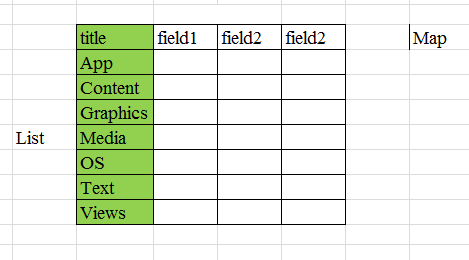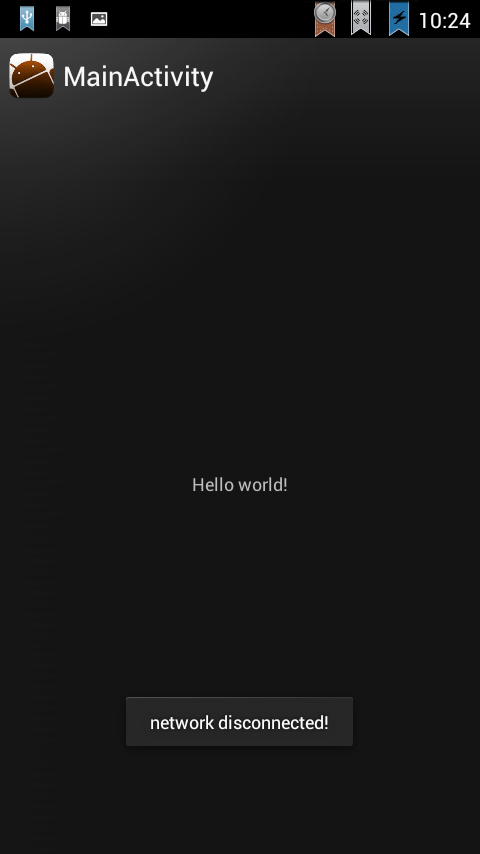編輯:Android開發實例
如上一節中所講的那樣創建了ApiDemo工程後,我們就可以進行每個示例代碼的分析了。讀者應對Android開發有基本的了解或讀過Android開發方面的基礎教程。
首先是看ApiDemo的主Activity:com.example.android.apis.ApiDemos,這個主Activity為ListActivity的子類,主要用來列出ApiDemos中的200多個實例,實例采取分類層次顯示。
在ApiDemos的onCreate()中的代碼:
Java代碼SimpleAdatper 作為數據源 getData(path) 與 UI ListActivity 之間的橋梁,它的構造函數如下:
SimpleAdapter(Context context, List<? extends Map<String, ?>> data, int resource, String[] from, int[] to)
我們知道ListActivity可以用來顯示一個列表,在使用SimpleAdapter時可以借用二維表來更好的理解。 SimpleAdapter的數據源data 類型為List<? extends Map<String, ?>> List 中每一項為一個Map對象,相當於二維表中一行,這一行可以有多列,每列可以有個名字,為Map<String,?> string ,相當於表的列名:

ApiDemos中每條記錄只顯示一列”title”。 android.R.layout.simple_list_item_1 為用來顯示每條記錄的Layout資源id, ListActivity允許使用自定義Layout ,這裡使用了Android系統資源,simple_list_item_1由一個TextView構成,其id為text1。
new String[] { “title” } 為需要顯示的列表的數組,ApiDemos只顯示一列“title”,如果有多列:則可以為new String[] { “title”,”field1”,”field2”,”field3” }。
new int[] { android.R.id.text1 }則指定使用 android.R.layout.simple_list_item_1 中 id 為text1的 TextView 來顯示 “title” 列。 如果有多列,Layout可以定義多個View (不一定都為TextView),然後為每列指定顯示的View的id。
再來看看getData(path)是如何定義的,protected List getData(String prefix) 返回一個列表。
Java代碼它通過PackageManager 從 AndroidManifest.xml中讀取所以Intent-Filter含有:Intent.ACTION_MAIN和Intent.CATEGORY_SAMPLE_CODE所有Activity信息。前面說過200多個示例根據其功能分類,比如 Hello World示例它的Label為
App/Activity/<b>Hello <i>World</i></b>,
表示它的分類為分類App下Activity子類。getData(String prefix)根據每個Activity的Label屬性和當前層次(prefix)來決定當前列表中某項為葉子列表項,還是分類列表項,如果是葉子列表項,則添加為activityIntent,當用戶點擊改列表項時則會觸發該示例。若是分類列表項,則添加為browseIntent,browseIntent還是觸發ApiDemos Activity,但Intent帶有Extra信息,表示需要顯示改分類下的子類:
Java代碼此時如果用戶點擊改節點列表項,則會進入還分類下級目錄。
Java代碼addItem 給返回的List中添加一項,每個記錄含兩列:“title”,“intent” ,其中只顯示“title”列,如果想要顯示“intent”列的信息,就不能使用android.R.layout.simple_list_item_1 了,這時可以另外定義一個Layout 來顯示多列數據。 intent可以為觸發示例,如”Hello World”或是下級示例列表,此時觸發的Activity還是ApiDemos。
此外,ApiDemo還定義了ApiDemosApplication做為Application的子類,如果需要在多個Activity共享一些數據,可以定義在Application中。如果使用了自定義的Application,別忘了修改AndroidManifest.xml ,如下:
XML/HTML代碼
 Android中BroadcastReceiver(異步接收廣播Intent)的使用
Android中BroadcastReceiver(異步接收廣播Intent)的使用
Broadcast Receiver簡介 Broadcast Receiver是Android的五大組件之一,使用頻率也很高。 用於異步接收廣播Intent,廣播
 android:descendantFocusability方法介紹
android:descendantFocusability方法介紹
此方法適用於所有母控件無法獲取焦點的情況 開發中很常見的一個問題,項目中的listview不僅僅是簡單的文字,常常需要自己定義listview,自己的Adapte
 Android MediaPlayer(多媒體播放)
Android MediaPlayer(多媒體播放)
Android提供了許多方法來控制播放的音頻/視頻文件和流。其中該方法是通過一類稱為MediaPlayer。Android是提供MediaPlayer類訪問內置的媒體播放
 Android中顯示GIF動畫的實現代碼
Android中顯示GIF動畫的實現代碼
本文實例講述了Android中顯示GIF動畫的實現代碼。分享給大家供大家參考,具體如下: gif圖動畫在android中還是比較常用的,比如像新浪微博中,有很多g